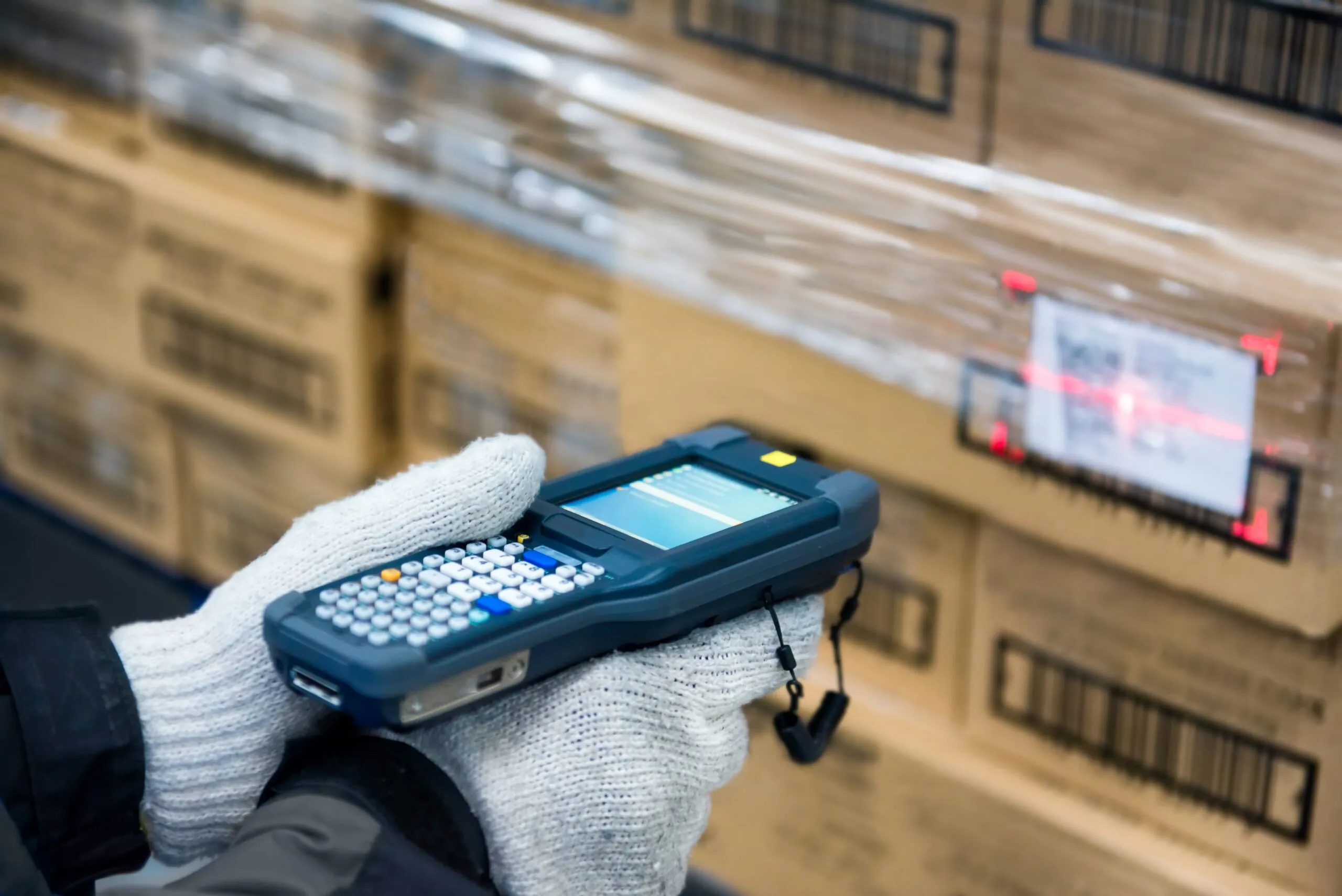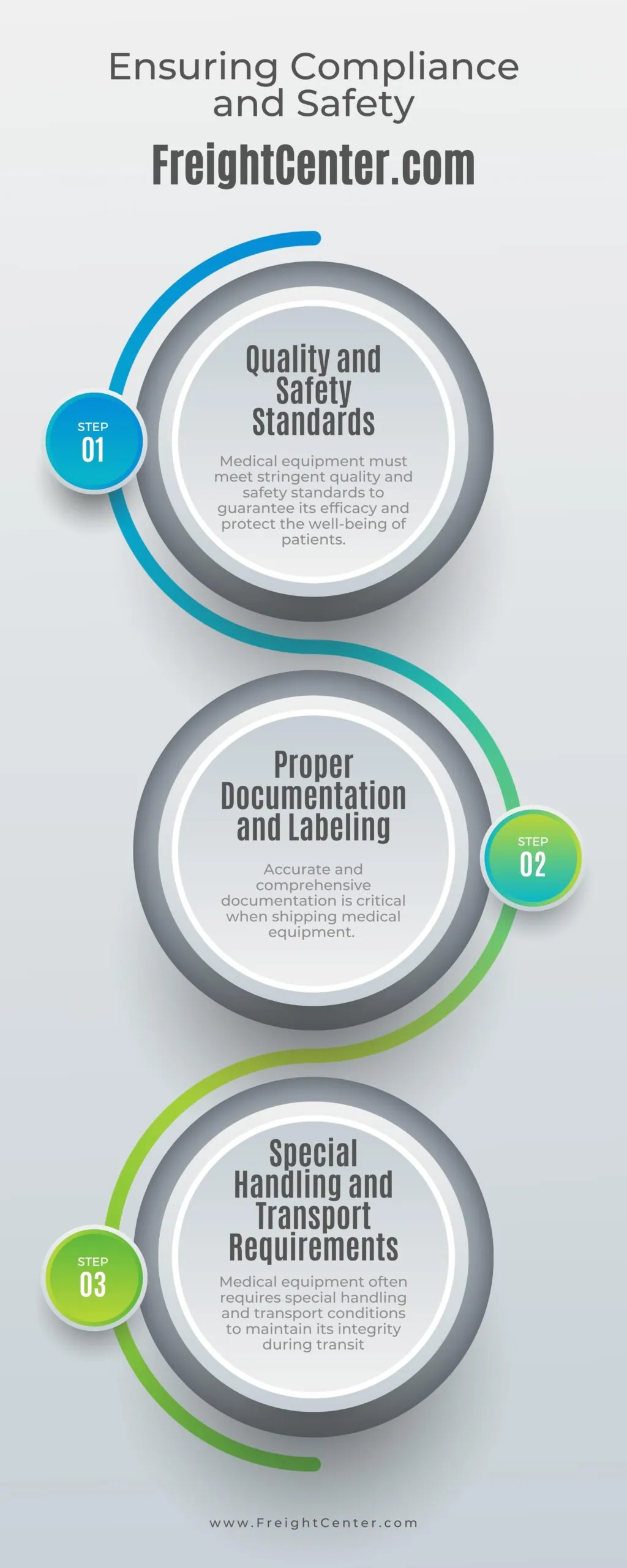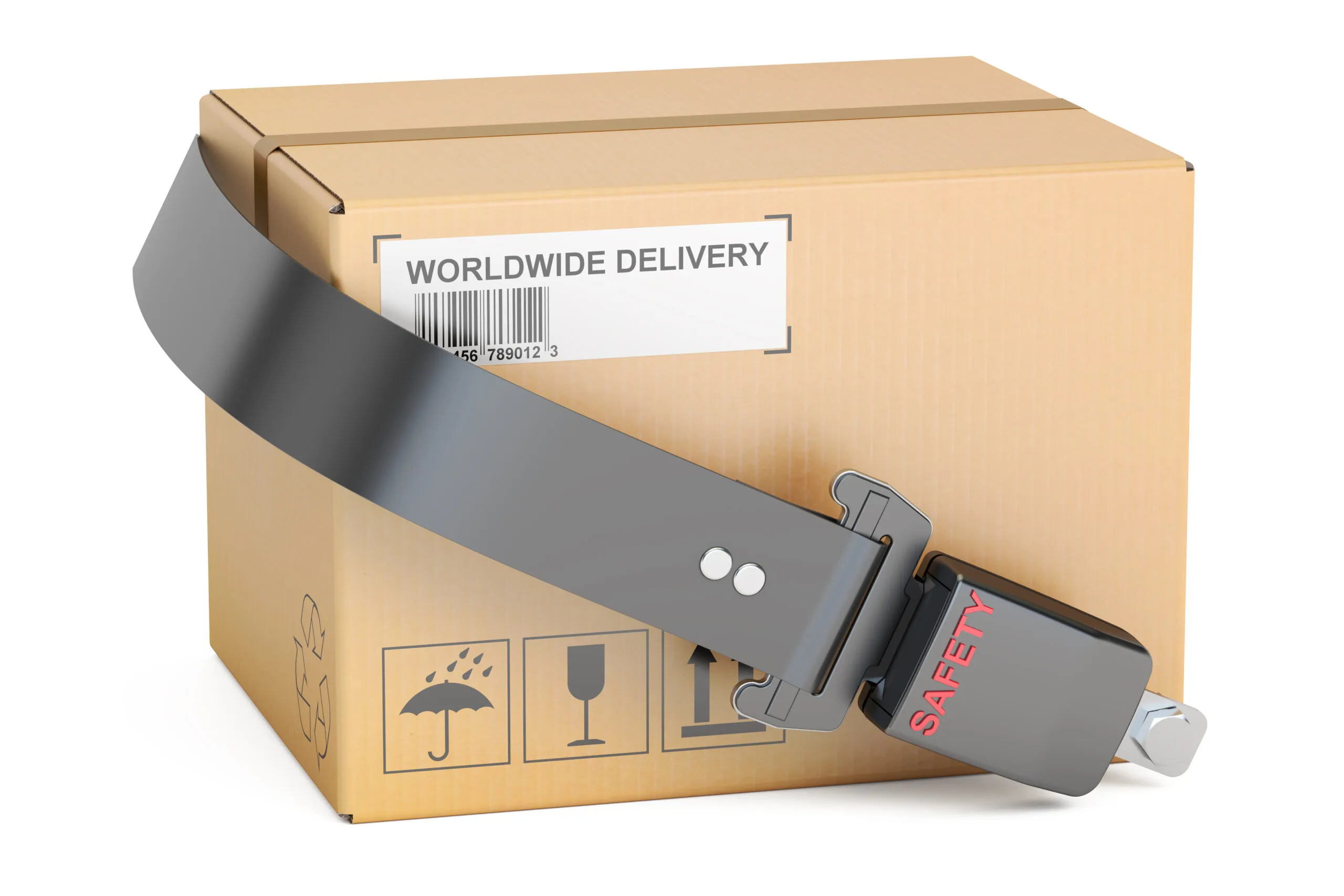
A Guide to Shipping Medical Equipment
Shipping medical equipment and supplies is a vital process that helps deliver essential items to hospitals and clinics around the world. From bandages to advanced machines, proper shipping ensures that these important tools reach their destination safely and on time.

Shipping medical supplies requires careful planning, compliance with regulations, and thoughtful consideration of various factors. By adhering to regulatory requirements, ensuring proper packaging, selecting the right shipping method, and providing any necessary special handling instructions, you can help guarantee the safe and timely delivery of medical supplies. At FreightCenter we can help you ship your medical supplies to any destination. Here are the fundamental steps and considerations for shipping medical equipment and supplies, ensuring that they arrive at their destination promptly and in optimal condition.
We provide competitive freight shipping prices and an all-inclusive, easy-to-use shipping experience for our customers. Exceeding our customers’ expectations results in thousands of satisfied customer reviews and repeat business. We believe in the power of our customer relationships. Check out FreightCenter reviews from real customers, and learn what they have to say about their freight shipping experience!
Awards and Endorsements
- 2021, 2017 & 2016 Food Logistics’ Top Green Providers
- 2021 & 2018 Supply & Demand Chain Executives’ Pros to Know: Matthew Brosious
- 2020 & 2019 Top Food Logistics’ 3PL & Cold Storage Provider Award
- 2020 & 2019 Business Observer’s Top 500 Companies on the Gulf Coast
- 2020 & 2017 SmartWay® Transport Partner
- 2020 & 2017 Food Logistics’ Champions: Rock Stars of the Supply Chain
- 2020 Best of Palm Harbor Awards for Local Businesses
- 2017 Green Supply Chain Award from Supply & Demand Chain Executive
- 2017 Tampa Bay Business Journal Heroes at Work
- 2016, 2015, & 2012 Food Logistics Top 100 Software and Technology Providers
- 2013 Tampa Bay Business 100 by Tampa Bay Business Journal
- 2013 Top 100 Great Supply Chain Partners by SupplyChainBrain
- 2012 TIA Samaritan Award Honorable Mention
- 2012, 2011 & 2010 TBBJ Fast 50 Recipient
- 2013, 2011, & 2010 Diversity Business Top Businesses

Packaging with Care
Packaging your materials is the first step in shipping medical equipment and supplies. Choose strong and durable boxes that are the right size for the items you want to send. To protect fragile equipment, use materials like bubble wrap or foam padding. Ensuring everything is well-packed will help prevent damage during the journey.
Labeling and Writing Information
It’s important to label the packages correctly. Write the recipient’s address and contact information clearly on the box. Include any special instructions or handling requirements. For example, let the shipping company know if the items are delicate or need to stay cool.
Choosing the Right Shipping Method
There are different ways to ship items, and picking the right one is essential. If you need to get something delivered quickly, choose a faster shipping option, like overnight or express. For items that need to travel far, it’s a good idea to use a reliable shipping company with experience in handling medical supplies.
Keeping Items Safe
Some medical equipment and supplies are sensitive to temperature changes. Medicines or vaccines must be stored at specific temperatures to remain effective. Use containers that can maintain the right temperature to keep these items safe during shipping. This way, they’ll be in excellent condition when they reach their destination.
Following Rules and Regulations
There are rules to follow when shipping medical equipment and supplies, just like in any game or activity. Different countries may have their own shipping rules, so learning about them is essential. Check if you need special permits or documents to send certain items overseas.
Insurance for Extra Protection
Sometimes, things might go differently than planned, even with the best efforts. That’s why it’s a good idea to get shipping insurance. Just like when you buy your bike or skateboard insurance, shipping insurance helps protect your medical equipment and supplies if something unexpected happens during transit.
Keeping Track
Keeping track of your shipment is essential. With modern technology, you can easily track where your package is and when it will arrive. This way, you can stay informed and tell the recipient when to expect their much-needed supplies.
Packaging Medical Equipment for Shipping: Ensuring Safety and Reliability

Understanding the Significance of Proper Packaging
Medical equipment is often delicate, sensitive, and expensive, making it susceptible to damage during transportation. Proper packaging is crucial to protect the equipment from impacts, vibrations, and other potential hazards during transit. Additionally, well-packaged medical equipment reduces the risk of functional failures or malfunctions, ensuring that it is ready for immediate use upon arrival at its destination.
Selecting the Right Packaging Materials
The choice of packaging materials is critical to safeguarding medical equipment during shipping. Opt for sturdy and durable materials that can withstand the rigors of transportation. Corrugated cardboard boxes are commonly used for their strength and ability to cushion against impacts. Consider using foam inserts or custom-molded packaging for delicate equipment to provide additional protection.
Disassembling and Securing Parts
Before packing medical equipment, consider disassembling detachable parts to reduce the risk of breakage during transit. Wrap individual parts in protective materials and secure them within the packaging to prevent shifting or collisions during shipping. Clearly label each part to make reassembling easier at the destination.
Bubble Wrap and Cushioning
Bubble wrap is an excellent material for cushioning and protecting delicate medical equipment. Wrap the equipment carefully with bubble wrap, paying particular attention to vulnerable areas like screens, knobs, and delicate sensors. Fill any empty spaces within the packaging with cushioning materials, such as foam, packing peanuts, or air pillows, to prevent movement during shipping.
Addressing Temperature Sensitivity
Some medical equipment, such as certain medications or diagnostic devices, may be sensitive to temperature fluctuations. Use insulated packaging or thermal liners to maintain the appropriate temperature during transit for temperature-sensitive items. Consider using gel packs or dry ice for temperature control, but comply with shipping regulations for such materials.
Securing and Labeling
Securely seal the packaging with strong tape to prevent it from opening during shipping. Place a clear, visible label on the box that indicates the contents, any handling instructions (e.g., “Fragile,” “Handle with Care”), and the recipient’s address and contact information. Accurate labeling ensures that the medical equipment reaches the correct destination promptly.
Custom Crating for Oversized Equipment
Custom crating may be necessary for large and heavy medical equipment to ensure safe transport. Custom crates are designed to fit the equipment precisely, providing the highest level of protection during shipping. They are often made of robust materials, such as plywood, to withstand the weight and demands of transportation.
Labeling Packages for Shipping Medical Equipment: Precision and Safety

The Importance of Accurate Package Labeling
Accurate package labeling is vital in the shipping process, especially for medical equipment. It provides essential information to shipping carriers, customs officials, and recipients, ensuring the package is handled correctly throughout its journey. Mislabeling or incomplete labeling can lead to delays, misrouting, or even the loss of valuable medical equipment.
Include Detailed Contact Information
Every package must have clear and legible contact information. Include the recipient’s complete address, including the street address, city, state or province, postal or ZIP code, and country. Double-check the accuracy of the information to avoid any misdeliveries.
Provide a Clear Return Address
In addition to the recipient’s address, ensure that the package carries a clear return address. This is particularly important if the package cannot be delivered and must be returned to the sender. It also serves as a point of contact for the recipient with any questions or concerns.
Indicate Special Handling Instructions
For medical equipment that requires delicate handling, indicate special instructions on the package, such as “Fragile” or “Handle with Care.” This notifies shipping personnel to exercise extra caution during the package’s journey, reducing the risk of damage to the valuable equipment.
Comply with Regulatory and Safety Requirements
When shipping medical equipment, it is essential to comply with all relevant regulatory and safety requirements. This includes any specific labeling or documentation needed for certain medical devices or equipment types. For international shipments, ensure compliance with customs regulations of the destination country.
Use Waterproof and Durable Labels
Medical equipment may be exposed to various weather conditions during shipping. To prevent the labels from smudging or becoming illegible, use waterproof labels that can withstand moisture and environmental factors. Durable labels will ensure that the necessary information remains intact throughout the journey.
Incorporate Barcode and Tracking Information
Utilize barcodes and tracking information on the package to streamline the shipping process. Barcodes enable efficient scanning and sorting, helping the package move swiftly through the shipping network. Tracking information allows the sender and recipient to monitor the package’s progress and receive real-time updates on its estimated delivery time.
Consider Temperature-Sensitive Indicators
Consider using temperature-sensitive indicators on the package for medical equipment sensitive to temperature. These indicators change color if the package has been exposed to extreme temperatures, alerting both the sender and recipient to potential issues with the equipment’s integrity.
Shipping medical equipment can incur substantial costs, especially for oversized or international shipments. Compare the shipping rates and service options of different carriers to find the most cost-effective solution without compromising safety and reliability.
FreightCenter can compare costs for you!
Customers can visit the FreightCenter website and input the details of their shipment, such as the pickup and delivery locations, dimensions and weight of the medical equipment, and any special requirements. The quoting process is straightforward and can be completed within minutes.
FreightCenter has a vast network of reputable carriers, including LTL (Less-Than-Truckload) and FTL (Full Truckload) carriers, as well as specialized carriers for handling medical equipment.
FreightCenter provides transparent pricing, meaning the quotes presented to customers include all the relevant costs associated with the shipment.
Once a shipment is booked through FreightCenter, customers can use their online tracking tools to monitor the status of their medical equipment throughout its journey.


Ensuring Compliance and Safety
Shipping medical equipment is a critical process that involves handling valuable and sensitive items used in healthcare. To ensure the smooth and secure transportation of medical equipment, it is vital to follow the rules and regulations set forth by governing bodies and international standards.
Ensuring Legal Compliance
One of the primary reasons for following rules and regulations when shipping medical equipment is to ensure legal compliance. Different countries and regions have specific laws and regulations governing the import and export of medical devices and equipment. Adhering to these regulations prevents potential legal issues, penalties, or delays in the shipping process.
Meeting Quality and Safety Standards
Medical equipment must meet stringent quality and safety standards to guarantee its efficacy and protect the well-being of patients. When shipping medical equipment, it is essential to ensure that the items comply with relevant quality and safety standards. This includes adherence to certifications like ISO (International Organization for Standardization) and CE (Conformité Européene) markings for medical devices sold in the European Economic Area.
Proper Documentation and Labeling
Accurate and comprehensive documentation is critical when shipping medical equipment. Ensure all required paperwork, including invoices, certificates, and permits, is complete and well-organized. Proper package labeling is also essential to provide essential information about the contents and facilitate customs clearance procedures.
Special Handling and Transport Requirements
Medical equipment often requires special handling and transport conditions to maintain its integrity during transit. For example, some medical devices may be sensitive to temperature fluctuations, requiring temperature-controlled shipping. Following regulations for special handling ensures that the equipment arrives in optimal condition, ready for immediate use.
Adhering to Customs Procedures
When shipping medical equipment internationally, customs procedures play a significant role in ensuring smooth and timely delivery. You must comply with customs requirements to avoid delays or even the seizure of the equipment. Properly preparing and providing accurate customs documentation is essential for a successful international shipment.
Protecting Patients and Healthcare Professionals
Complying with rules and regulations when shipping medical equipment is not just about legal and logistical considerations; it directly impacts patient care and the well-being of healthcare professionals. By ensuring that medical equipment meets safety standards and is transported under the proper conditions, you contribute to the safe and effective use of the equipment in patient treatment.
Gaining Trust and Credibility
Following rules and regulations in shipping enhances your credibility as a reliable and responsible healthcare provider or supplier. Healthcare facilities and institutions trust suppliers who prioritize compliance with industry regulations, making it more likely that they will continue to engage in business partnerships.



